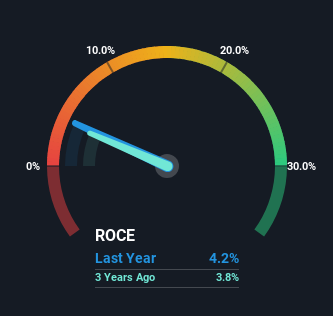- United States
- /
- Electric Utilities
- /
- NYSE:DUK
Duke Energy (NYSE:DUK) Has More To Do To Multiply In Value Going Forward

Did you know there are some financial metrics that can provide clues of a potential multi-bagger? Firstly, we'll want to see a proven return on capital employed (ROCE) that is increasing, and secondly, an expanding base of capital employed. This shows us that it's a compounding machine, able to continually reinvest its earnings back into the business and generate higher returns. However, after investigating Duke Energy (NYSE:DUK), we don't think it's current trends fit the mold of a multi-bagger.
Return On Capital Employed (ROCE): What Is It?
If you haven't worked with ROCE before, it measures the 'return' (pre-tax profit) a company generates from capital employed in its business. Analysts use this formula to calculate it for Duke Energy:
Return on Capital Employed = Earnings Before Interest and Tax (EBIT) ÷ (Total Assets - Current Liabilities)
0.042 = US$6.8b ÷ (US$181b - US$17b) (Based on the trailing twelve months to September 2023).
Therefore, Duke Energy has an ROCE of 4.2%. On its own that's a low return on capital but it's in line with the industry's average returns of 4.4%.
View our latest analysis for Duke Energy

Above you can see how the current ROCE for Duke Energy compares to its prior returns on capital, but there's only so much you can tell from the past. If you'd like, you can check out the forecasts from the analysts covering Duke Energy here for free.
What Does the ROCE Trend For Duke Energy Tell Us?
In terms of Duke Energy's historical ROCE trend, it doesn't exactly demand attention. The company has employed 27% more capital in the last five years, and the returns on that capital have remained stable at 4.2%. This poor ROCE doesn't inspire confidence right now, and with the increase in capital employed, it's evident that the business isn't deploying the funds into high return investments.
Our Take On Duke Energy's ROCE
In conclusion, Duke Energy has been investing more capital into the business, but returns on that capital haven't increased. Unsurprisingly, the stock has only gained 26% over the last five years, which potentially indicates that investors are accounting for this going forward. Therefore, if you're looking for a multi-bagger, we'd propose looking at other options.
Duke Energy does have some risks, we noticed 2 warning signs (and 1 which shouldn't be ignored) we think you should know about.
If you want to search for solid companies with great earnings, check out this free list of companies with good balance sheets and impressive returns on equity.
New: Manage All Your Stock Portfolios in One Place
We've created the ultimate portfolio companion for stock investors, and it's free.
• Connect an unlimited number of Portfolios and see your total in one currency
• Be alerted to new Warning Signs or Risks via email or mobile
• Track the Fair Value of your stocks
Have feedback on this article? Concerned about the content? Get in touch with us directly. Alternatively, email editorial-team (at) simplywallst.com.
This article by Simply Wall St is general in nature. We provide commentary based on historical data and analyst forecasts only using an unbiased methodology and our articles are not intended to be financial advice. It does not constitute a recommendation to buy or sell any stock, and does not take account of your objectives, or your financial situation. We aim to bring you long-term focused analysis driven by fundamental data. Note that our analysis may not factor in the latest price-sensitive company announcements or qualitative material. Simply Wall St has no position in any stocks mentioned.
About NYSE:DUK
Duke Energy
Through its subsidiaries, operates as an energy company in the United States.
Average dividend payer and fair value.
Similar Companies
Market Insights
Community Narratives




